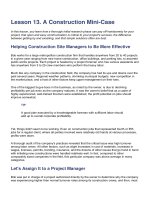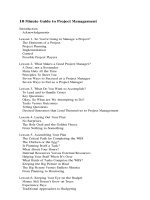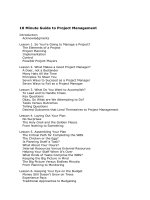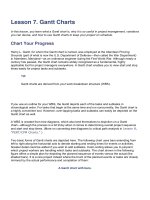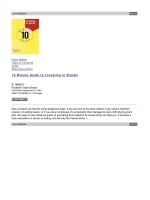management alpha 10 Minute Guide to Project Management PHẦN 8 pps
Bạn đang xem bản rút gọn của tài liệu. Xem và tải ngay bản đầy đủ của tài liệu tại đây (32.81 KB, 13 trang )
No one likes to read a report filled with fluff, and no one likes to be deceived. Stay on the up and
up and develop your reputation as a project manager of integrity.
The 30-Second Recap
● The increasing number of communication vehicles make it more difficult to get the attention
of those to whom you must report.
● For scheduled presentation of any variety the key word is preparation.
● A hard-copy note in this day and age sometimes gets more attention than voice mail and e-
mail.
● As PC screens get larger and sharper, your reports including charts and slides that you
send over look magnificent.
● Incorporate the words of others and give credit to the group, but personally accept blame.
Be entirely honest when it comes to addressing your own performance.
Lesson 10. Choosing Project Management
Software
In this lesson, you learn the kinds of software that are available, the capabilities of software, which
software functions are crucial, and guidelines for selection.
With the Click of a Mouse
Project management software today is available at a variety of prices, offering a wide variety of
functions. You can use software to plan, initiate, track, and monitor your progress. You can
develop reports, print individual charts, and at the push of a button (or a click of a mouse) e-mail
virtually any aspect of your project plans to any team member, top manager, executive, or
stakeholder.
Whereas earlier versions of PM software focused on planning, scheduling and results, tools for
analyzing your progress, finding critical paths, and asking "what if" questions were lacking.
CAUTION
Today, there are so many options in and among so many vendors that the problem
is finding your way through the bewildering choices.
Bennett Lientz and Kathryn Rea in Project Management for the 21st Century observe that project
management software has at least five distinct differences from more widely known and used word
processing, database, and spreadsheet software:
● PM software is used far less often than other categories of software.
● Fewer people use PM software, although project participants and stakeholders usually do
see the generated output.
● PM software allows for more customization than many other types of software.
● PM software tends to be more expensive than commonly used, widely known types of
software.
● Fewer people in your work sphere are likely to know how to use PM software.
Leave a Good Thing Alone
Project management software went from being expensive and crude, to less expensive and highly
functional, to even less expensive, but confusing. When Harvard Project Manager was launched in
1983 it represented a breakthrough in PM software. Its main focus was on project budgeting,
scheduling, and resource management. With Harvard Project Manager you were able to generate
Gantt charts, PERT/CPM charts, and a variety of other charts and tables. It was considered an
integrated project planning and control package and sold for as little as 30 percent of the price of
its clunky, less functional predecessors.
In the two decades that followed, competition among PM software vendors heated up, prices came
down, and functionality went sky high. Many packages now are harder to learn and use. Consider
your own experience in using word processing, database, or spreadsheet software. Aren't there
earlier versions of current programs that were easier and more convenient? You were able to pop
them in, learn them in a day or so, and go on your merry way.
Today, with expanding megabyte counts, it seems that the vendors need to have everything plus
the kitchen sink. This gives them the opportunity to design splashy ads listing umpteen features.
Realistically, how many people are true power users who would use all of the advertised features?
CAUTION
Whereas the Harvard Project Manager could be learned in as little as a day if you
were diligent, current PM software can take as much as five days of your time, if
you are starting from square one and have no PC guru or mentor nearby to steer
you along.
Whose Choice Is It?
Certainly, if your organization, department or division already uses or prefers a certain type of
software, then your decision is already made. Your quest becomes mastering that software—or at
least the parts of it that are crucial for you to know.
TIP
If a brand of PM software is the preferred choice in your workplace, and other
projects employ such software, you are relatively fortunate. Other project
managers or staff will know how to use it and can serve as ad-hoc software gurus
to you.
With no experienced users in your work setting, some important questions arise:
● What kind of software should be chosen?
In choosing PM software a rule of thumb is to choose a popular and very well-known
package. The price is likely to be highly competitive, people around you would have either
heard of the vendor or have heard that the software is widely known, and you won't have to
spend a lot of time defending your decision!
● Who should learn it?
If you and you alone will have responsibility for learning the software, you need to build
time and expense into your budget—it will take you time to learn it or to take a course, and
your time has a cost.
TIP
The Project Management Institute at and the Project
Management Control Tower at each offer a wide variety
of books, audio-visual materials, training guides, classroom training, seminars, and
increasingly, online training. Also, PMFORUM at
offers a host of career opportunities for
project managers or those seeking to enter the profession.
While it may seem obvious that you as the project manager should be the primary user of PM
software, you may need to rethink that assumption. Depending on what you are managing and the
dynamics of your organization, if you were to be the primary software user, you might spend the
brunt of your time working with the software and have precious little time left for forming and
building your team, maintaining reporting requirements, and offering the overall kind of day-to-day
project management that the venture requires.
Recognizing the danger of having a project manager become too immersed with project
management software, some organizations have established support groups or provide internal
software gurus. These gurus are the in-house experts and are often loaned to project
management teams for the duration of the project.
The gurus work directly with the project manager, incorporating his feedback, answering his
questions, and undertaking whatever types of analysis the project manager requests. They
routinely maintain schedules, budget reports, and track the allocation of resources. An
experienced software guru knows how and how often to share project related reports with project
staff and project stakeholders in general.
What's Your Pleasure?
Assuming that you're not in the position where your organization will loan someone to you who will
handle the brunt of PM software activities and assuming that there is no particular program of
choice yet established, how do you go about selecting software?
First, establish what kind of user you're going to be, which is largely determined by two elements:
the size of your project and how technical you are.
For tiny projects of zero to two staff for a project of a few months or less, it's possible that no
project management software is necessary! How so? You may already possess all the software
and software knowledge you need to be effective in managing a small project. We're talking about
spreadsheets, word processing, a graphics or drawing program, and the functionality to generate
tables, graphs, flow charts, and other diagrams.
TIP
Though somewhat makeshift, the combination of reports and exhibits that you can
muster with your current software and skills might be more than adequate for your
project needs.
Your current software may be entirely adequate if the basic work breakdown structure (WBS) and
a Gantt chart or two is all you need, and you don't necessarily have to create a critical path.
For projects involving four or more people, extending several months or longer, with a variety of
critical resources, it makes sense to invest in some type of software. Again, it doesn't necessarily
need to be PM software per se. Many calendar and scheduling software programs come with built-
in functions. You can produce tables, Gantt charts, and even maintain a schedule for four to ten
people. Increasingly, you can do this on hand-held computers.
TIP
With a total project management team of four people, extended over several
months, employing dedicated PM software may make the most sense.
Dedicated PM Software
The competition among dedicated PM software vendors is keen. Major vendors in the field include
PlanView, Inc., Primavera, Microsoft, Dekker Welcome, and Artemus. (An overview of PM
software with descriptions can be found in the next lesson.) There are also lower-end programs
that will help you generate plans, project reports, and basic charts that don't require as much
learning time. Products such as Quick Gantt, Milestone Simplicity, and Project Vision sell for less
than $100 and are available at office superstores as well as retail software stores.
TIP
Inexpensive PM software may be your best option if you don't have anyone else in
the organization who can serve as guru, but you do wish to automate, rather than
manually generate critical reports and charts.
Suppose that you are managing many people over many months, and have a thousand or more
tasks and subtasks to complete. Here, you would look at PM software for midrange project
managers. You can spend anywhere from $200 to $6,000 using the more feature-laden versions
of software named above. Most packages will give you the full range of tools sought by even
veteran project managers on multiyear projects.
The problem with software at this level is that you can quickly become a slave to it. For example,
will you decide to schedule and track all subtasks and tasks based on identified start times, stop
times, for each staff member, all the time? Or, will you continually rely on your staff to give you
estimates of tasks and subtask completion times?
● Relying on the input of your staff helps to build a team, but it takes more work.
● Using the software is arduous at first, saves time later, and keeps your head in front of a
PC screen more often—away from the people and the events happening all around you.
High-end project management software is designed for the very largest, longest duration, most
involved types of projects. If you are a high-end user, you wouldn't have picked up this book. Here,
we are talking about software that can range from a few thousand to several thousand dollars.
Learning such packages could take weeks. The software selection process alone could take
weeks or months.
CAUTION
Even if at the high end there are so many programs available, made by such
vendors as Cobra, Semantic, Instaplan, Klavis (for Mac users), Open Plan,
Primavera, Microsoft, Enterprise PM, Microplanner, and others, that you would
need a consultant to make such a selection.
Regardless of your level of PM software knowledge, your selection could be one of the most
important factors in overall project success. Many project managers have found that the software
in force is too complex and too unwieldy to use for the entire project. Some end up using only an
element of the software, such as budgeting or scheduling; some use it only for making charts;
others end up abandoning the software midstream. Undoubtedly, a whole lot of scrambling follows
because whatever the software was used for now needs to be done manually.
How Will You Use PM Software?
The first time, modest users obviously won't use PM software the way that an experienced pro will.
Nevertheless, there are levels of usage worth differentiating:
● Reporting
Here the project manager uses the software to generate Gantt or, possibly, PERT/CPM
charts. She may use other software programs such as word processing and spreadsheets
to supplement her project graphs and produce reports.
● Tracking
The software is used to compare actual versus planned progress. As the project staff
completes tasks and subtasks, the results of their efforts are logged so that the tracking
effort stays current.
Plain English
Project tracking
A system for identifying and documenting progress performance for effective
review and dissemination to others.
● What-if
The PM software is engaged to identify the impact of shuffling resources, changing the
order of subtasks, or changing tasks' dependencies. What-if analysis is kind of fun,
because you get immediate feedback.
CAUTION
Change one variable at a time to have a full grasp of its impact. If you change too
many variables at once, the picture becomes cloudy.
● Cost control
Project managers use PM software to allocate costs to various project resources. This is
usually done by figuring out how much resource time and effort is consumed. Lientz and
Rea observe that "most project management software systems lack flexibility in handling
costs as well as interfaces into budgeting and accounting systems." Thus, the cost
computations that a project manager makes generally don't plug into the overall cost
structures the accountants in her organization work with.
● Clocking
By adding project team member hours expended on various tasks and subtasks on a
regular basis, project managers can then generate reports showing actual versus
scheduled use of resources.
Checklists and Choices
It's hard to generalize what type of software various levels of users may require, but here are some
general criteria worth considering:
● Ease of use
Is the software easy to plug in, are there good help screens, is there a tutorial, is there
strong customer support, and is the software menu driven and intuitive? Is it easy to move
things around, are the commands as standard as possible and easy to learn? Is there an
accompanying manual that is easy to read? Are you able to get started on some functions
quickly?
● Reporting functions
Does the program allow for individual revising of report formats, can these be easily
imported into other software programs, and can they easily be saved, added to, combined,
and read?
● Charting capacity
Does the software offer the basic project management charts (virtually all do), is there
automatic recalculation, are there easy-to-use options, and are there drag and drop
capabilities? Can charts be imported and exported easily, are supporting graphics easy to
see and to use, and can charts readily be changed into other forms?
● Calendar generators
Does this software allow for calendars of all durations, in a variety of formats, for different
aspects of the project and project staff, with the ability to mark particular days and times,
with holidays and other nonworking days preprogrammed, and are these calendars also
easily importable and exportable?
● Interfacing
Can you easily connect with telecommunication systems and is information easily shared
with others who require online access? Is it efficient in terms of byte space consumed?
● Report generation
Can a variety of report formats be selected, with quick changing capabilities, and easy
transference to word processing software?
In addition, consider these attributes:
● Shows onscreen previews of reports prior to printing
● Offers a variety of formats for Gantt and PERT charts
● Works with a variety of printers and other equipment
● Enables several projects to share a common pool of resources
● Conveys cost data by task or by time
● Allows printing of subsections of charts
● Accepts both manual and automatic schedule updates
Most of the vendors you will encounter have such capabilities. Hence, you need to go beyond a
strict comparison of software functionality and consider the attributes, benefits, and services of
using a particular vendor as well. In fact, for any major purchase it's advisable to have a good set
of questions. The following is a list adapted from my book The Complete Idiot's Guide to Managing
Stress. Ask the vendors whether they
● Offer any corporate, government, association, military, and educators' discounts?
● Have weekly, monthly, or quarterly seasonal discounts?
● Offer off-peak discounts?
● Guarantee the lowest price?
● Accept major credit cards?
● Accept orders by fax or e-mail?
● Have a money-back guarantee, or other guarantee?
● Use a 1-800 ordering fax line?
● Guarantee shipping dates?
● Have a toll-free customer service line?
● Avoid selling, renting, or otherwise using your name and ordering information?
● Insure shipments?
● Charge for shipping and handling?
● Include tax?
● Have any other charges?
● Have demos?
● Offer free or low-cost upgrades?
● Have references available?
● Keep a list of satisfied customers in your area?
● Have been in business long?
● Have standard delivery times?
● Warranty the product?
Making a List, Checking It Twice
After you've established your own set of selection criteria in consideration of all the things that your
project entails and in consideration of the various attributes, benefits and features of working with
each vendor, engage in a useful exercise: Decide on paper what you must have versus what it is
nice to have versus what is not needed, but you will take it if it is offered.
Then, using articles, product reviews, and the vendors' Web sites, make a preliminary survey of
the various packages available and how they stack up. A simple matrix or grid with the vendors
listed across the top representing columns, and the important attributes to you down the left side of
the page will suffice.
CAUTION
Selection processes can be brutal. You may encounter ten or twelve possible
vendors, but try to knock down the list early to three to five. Sometimes, a
particular feature is so outstanding that it outweighs other mediocre elements of a
vendor's overall package.
Most vendors will readily offer you product demonstrations. Down loadable product demos often
are available at the vendor's Web site. Otherwise, demos can often be observed over the Internet.
TIP
Some vendors allow you to download a full package, available for a limited
duration.
If you've narrowed the field to three or four vendors, you have a fighting chance of identifying the
one that best meets your needs.
TIP
If at all possible, observe the software actually in use either in your own
organization or someplace else.
Observing software in use is most telling. Someone in the field, actually using the software, can
provide first-person input as to where the software shines and doesn't shine. You get far richer
information than you can get from a Web site or, for that matter, a product demo.
The 30-Second Recap
● PM software has become more sophisticated and more bewildering. Many packages will
do the jobs you need to do, but are so difficult to learn and to master that you waste
valuable resources, namely your time. Worse, you end up abandoning the package.
● Many organizations loan software gurus to a project or have other project managers who
can supply ad hoc mentoring. If this applies to you, consider yourself fortunate.
● Don't get so immersed in software that you lose contact with your project team and the
environment that surrounds you.
● Choosing the right software may be vital. Predetermine your selection criteria so that you're
not buffeted by an endless array of options, benefits and features.
Lesson 11. A Sampling of Popular Programs
In this lesson, you learn which software programs are popular, what vendors have to say about
their own programs, and how to get in touch with vendors.
Yesterday's News
As each day passes, any software program evaluation presented in any book ages and soon
becomes obsolete. Consequently, the surveys and review of products listed in this lesson are
presented for the sake of example only!
A survey titled "Tools of the Trade: A Survey of Project Management Tools" appeared in the
September 1998 issue of the Project Management Journal. The Journal evaluated what the
authors called "Top Project Management Tools." Some 159 project managers responded to survey
questions out of 1,000 managers initially contacted. The typical respondent had slightly more than
10 years of project management experience and slightly more than 12 years' experience in the
field of information systems. Hence, this was a select group of veteran project managers.
The 159 respondents cited 79 different project management tools that they either were using
currently or had used within three years. Of note, the top 10 of these 79 tools were identified by
three-quarters of the respondents. The top 10 tools in order were
1. Microsoft Project
2. Primavera Project Planner
3. Microsoft Excel
4. Project Workbench
5. Time Line
6. Primavera SureTrak
7. CA-SuperProject
8. Project Scheduler
9. Artemis Prestige
10. FasTracs
Microsoft Project was the most frequently used PM software at the time of the survey. This is
somewhat understandable. In the late 1990s, Microsoft dominated all channels of software
advertising and promotion.
Artemis Prestige, Primavera Project Planner, and Project Scheduler were sited as being used
more often for projects lasting six months or longer. However, for overall satisfaction with project
management software, the ratings were close, with Project Scheduler first, followed by Primavera
Project Planner, Project Workbench, Microsoft Excel, Primavera SureTrak, and CA-SuperProject.
Thereafter, the score began to fall off a bit.
These programs were rated as to content, accuracy, format, ease of use, timeliness, and then
given an overall rating. The top five or six choices in terms of overall satisfaction closely matched
the top five or six software packages for which project managers routinely received the most
training within their organizations.
However, FasTracs was one product for which managers routinely had no hours of training, and
yet it received a remarkably high score. This was especially true in terms or "overall adequacy"
when respondents were asked how many months they had been working with the various software
products, and how many hours a week they spent using them. Thus, based on this one study,
FasTracs would be the product of choice for the first-time or light user, if all things could be held
constant.
TIP
Not surprisingly, the training time that project managers received for the various
software packages (that they were charged with learning) influenced how
adequate they thought the software to be. Said alternatively, the more training you
have to work with a particular type of project management software, the higher you
tend to rate that software.
Armed and Online
Flash forward to today, when more and more project management tools have an online
component. The power and capability of such programs is awesome.
The following is but a snapshot in time as to what is available now, largely in the words of the
vendors themselves.
CAUTION
The array of software options available today is even more bewildering than that of
years ago.
